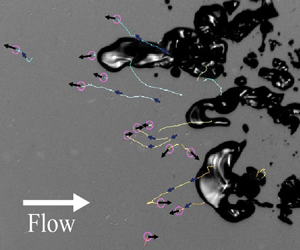Article contents
On the mechanisms that sustain the inception of attached cavitation
Published online by Cambridge University Press: 26 August 2020
Abstract

This experimental study addresses the longstanding question of why inception of attached cavitation on curved surfaces or hydrofoils at incidence is relatively insensitive to the concentration of free-stream nuclei. High-speed imaging and high-resolution particle image velocimetry measurements examine cavitation inception on three curved surfaces with varying pressure minima followed by regions with adverse pressure gradients. When these pressure gradients either thicken the boundary layer or cause local flow separation, thin  $(50\text {--}60\ \mathrm {\mu }\textrm {m})$ low-momentum zones form close to the wall. Microbubbles trapped in these regions are generated initially from the collapse of intermittent attachment of travelling bubble cavitation. These bubbles migrate slowly upstream for a few milliseconds either under the influence of the adverse pressure gradients when the flow remains attached or carried by the recirculating flow when the boundary layer is separated. Their speed is only 2 %–4 % of the free-stream velocity, and their trajectories are erratic, indicating near-dynamic equilibrium. Owing to the low local pressure, their diameter increases by two to four times by non-condensable gas diffusion, from
$(50\text {--}60\ \mathrm {\mu }\textrm {m})$ low-momentum zones form close to the wall. Microbubbles trapped in these regions are generated initially from the collapse of intermittent attachment of travelling bubble cavitation. These bubbles migrate slowly upstream for a few milliseconds either under the influence of the adverse pressure gradients when the flow remains attached or carried by the recirculating flow when the boundary layer is separated. Their speed is only 2 %–4 % of the free-stream velocity, and their trajectories are erratic, indicating near-dynamic equilibrium. Owing to the low local pressure, their diameter increases by two to four times by non-condensable gas diffusion, from  $10$ to
$10$ to  $30\ \mathrm {\mu }\textrm {m}$ to the thickness of the low-momentum zone. At that time, either they are swept downstream by the free-stream flow or they become nuclei for new attached cavitation events. When the new patches collapse, new microbubbles form and the process repeats itself frequently, and independently of the free-stream nuclei. These phenomena do not occur when the adverse pressure gradients are too mild to create low-momentum zones with sufficient thickness to facilitate the slow upstream migration and growth.
$30\ \mathrm {\mu }\textrm {m}$ to the thickness of the low-momentum zone. At that time, either they are swept downstream by the free-stream flow or they become nuclei for new attached cavitation events. When the new patches collapse, new microbubbles form and the process repeats itself frequently, and independently of the free-stream nuclei. These phenomena do not occur when the adverse pressure gradients are too mild to create low-momentum zones with sufficient thickness to facilitate the slow upstream migration and growth.
JFM classification
- Type
- JFM Rapids
- Information
- Copyright
- © The Author(s), 2020. Published by Cambridge University Press
References
REFERENCES
- 15
- Cited by





